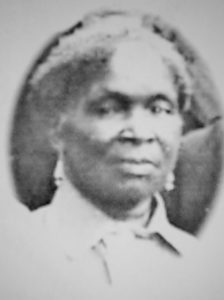Lucy Higgs Nichols
Historical Significance

Lucy Higgs Nichols (April 10, 1838 – January 25, 1915) was an African American escaped slave, and a nurse for the Union Army during the American Civil War. Known affectionately as “Aunt Lucy”, her sole photo shows her surrounded by veterans of the 23rd Indiana Volunteer Infantry Regiment, of the Army of the Tennessee. She was as devoted to the soldiers as they were to her and her daughter, Mona. She lost her daughter and husband during the Civil War, and after the war ended, settled in New Albany, Indiana, where she worked as a housekeeper to several officers and eventually married her second husband, John Nichols. She lived in New Albany with her husband for more than forty years, until her death on January 25, 1915, at the Floyd County Poor House.
The Grand Army of the Republic admitted her as their only honorary, female member, not only of Sanderson’s Post, men’s group, but of the United States. “Aunt Lucy” was treated as family, and loved by all the soldiers that knew her. Due to their sustained efforts, she was granted her government pension for diligent nursing and other services with them, in 28 battles, from June 1862 through the end of the war. She marched in victory with the troops in Washington, D.C., on May 23, and May 24, 1865, for the Grand Review of the Armies. Although her accomplishments were buried in archives for more than 100 years, in 1898, newspaper articles, about the special act of congress that granted her pension, spread her fame across the country. These newspapers included The Janesville Gazette, The Salem Democrat, Atlanta Constitution, The Logansport Journal, The Denver Post, The Freeman, and The New York Times.

Website
https://en.wikipedia.org/wiki/Lucy_Higgs_Nichols